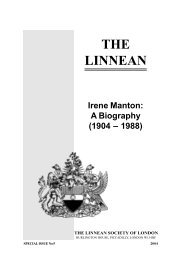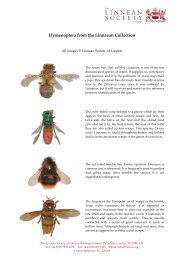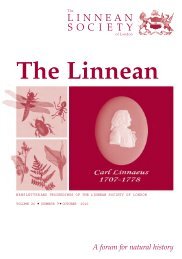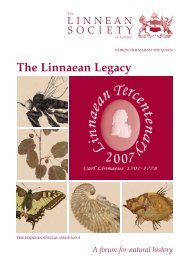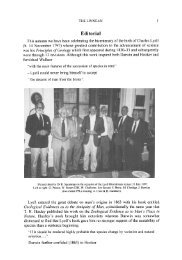Vol 25, no 3, October - The Linnean Society of London
Vol 25, no 3, October - The Linnean Society of London
Vol 25, no 3, October - The Linnean Society of London
Create successful ePaper yourself
Turn your PDF publications into a flip-book with our unique Google optimized e-Paper software.
38<br />
THE LINNEAN 2009 VOLUME <strong>25</strong>(3)<br />
In order to set Darwin’s lichens in their correct historical and geographical<br />
perspective, a few basic questions should be considered. (1): What was k<strong>no</strong>wn <strong>of</strong><br />
lichens worldwide and who were the leading liche<strong>no</strong>logists in the early 1830s when<br />
Darwin was contemplating his forthcoming long voyage on the Beagle from 1832-<br />
1836? (Barlow 1945; Keynes 1988, 2002; Browne 1995); (2): What was k<strong>no</strong>wn <strong>of</strong> the<br />
lichens <strong>of</strong> South America at the time <strong>of</strong> Darwin’s visit? (3): How much might Darwin<br />
have k<strong>no</strong>wn about lichens at the time <strong>of</strong> the voyage?<br />
(1) As a student at Cambridge (1828-1831), Darwin was greatly influenced by the<br />
Pr<strong>of</strong>essor <strong>of</strong> Botany, John Stevens Henslow, who was both his mentor and friend<br />
(Barlow 1967; Browne 1995; Walters & Stow 2001). Liche<strong>no</strong>logy in Britain was then<br />
at a low ebb (Hawksworth & Seaward 1977; Laundon & Waterfield 2007). Three<br />
decades earlier, the Swedish liche<strong>no</strong>logist, Erik Acharius (1757-1819), Linnaeus’s<br />
last student (Kärnefelt & Frödén 2007), had set systematic liche<strong>no</strong>logy on a bright<br />
new path when he segregated Linnaeus’s collective genus Lichen into smaller<br />
independent genera, consolidating his new arrangement in three important foundational<br />
books, the Methodus (Acharius 1803), Liche<strong>no</strong>graphia Universalis (Acharius 1810)<br />
and the Sy<strong>no</strong>psis methodica lichenum (Acharius 1810). His ideas were quickly taken<br />
up in Britain by Dawson Turner and William Borrer, and then W.J. Hooker (Hooker<br />
1829-1866; Turner & Borrer 1839; Hawksworth & Seaward 1977; Galloway 1981a,<br />
1988; Seaward 2002; Laundon & Waterfield 2007), but much less enthusiastically by<br />
James Edward Smith, who, while admiring Acharius’s k<strong>no</strong>wledge and industry, would<br />
<strong>no</strong>t subscribe to the new segregate genera. On receiving a copy <strong>of</strong> Acharius’s Methodus<br />
he wrote to Acharius in 1804 explaining his conservative position “… do <strong>no</strong>t blame<br />
me if my opinion on speculative points differs sometimes from yours. Neither dare I<br />
change names so freely as you have done. I must keep in view those Laws <strong>of</strong> Linnaeus<br />
which are sanctioned by experience and founded in justice…It is easy e<strong>no</strong>ugh to use<br />
new words. Genius appears best in using old ones properly…I regret that there should<br />
be a word in your excellent book that I can<strong>no</strong>t zealously defend as a friend ought: but<br />
I k<strong>no</strong>w we can<strong>no</strong>t all think alike in philosophy any more than in religion…” (Galloway<br />
1988: 165).<br />
Acharius’s world view <strong>of</strong> lichens in 1814 amounted to 906 species in 43 genera<br />
(Acharius 1814; Kärnefelt & Frödén 2007) and by the early 1830s, the number <strong>of</strong><br />
species was slowly starting to grow, when the impetus for lichen taxo<strong>no</strong>my passed<br />
from Sweden to France and Germany, with the work <strong>of</strong> such liche<strong>no</strong>logists as Fée<br />
(1824-1837), Eschweiler (1824), Wallroth (1824) and Delise (18<strong>25</strong>a, 18<strong>25</strong>b) creating<br />
new names and opening up new vistas. But liche<strong>no</strong>logy remained poised, waiting for<br />
a catalyst to open the still-closed book <strong>of</strong> Southern Hemisphere liche<strong>no</strong>logy. As we<br />
shall see, Darwin was to be very much part <strong>of</strong> that necessary catalyst.<br />
(2) When the Beagle sailed from Plymouth on 27 December 1831 bound initially<br />
for southern South America via the Cape Verde Islands and Brazil, what in fact was<br />
k<strong>no</strong>wn <strong>of</strong> the lichens <strong>of</strong> South America? Not a lot. From Commerson’s collections<br />
made from the Straits <strong>of</strong> Magellan in 1767, Jacquin (1781) described Lichen aurantiacoater<br />
[= Usnea aurantiaco-atra (Walker 1985: 62)] and L. antarcticum [= Nephroma<br />
antarcticum (White & James 1988)]. Cook’s three voyages yielded several collections<br />
from Banks & Solander, the Forsters & Sparrman and Anderson, but only one species



